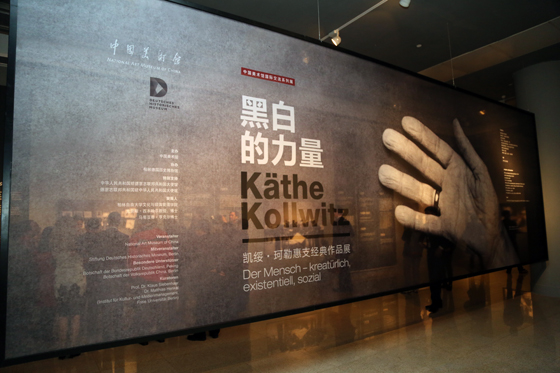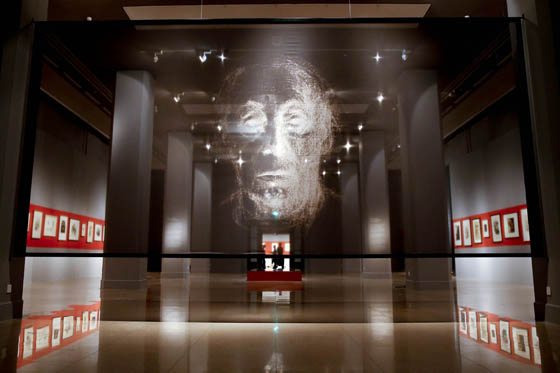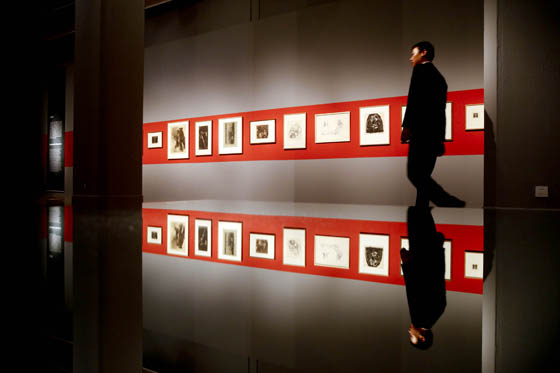NAMOC International Exchange Exhibition Series: Power of Black and White -- Käthe Kollwitz Classic Works Exhibition opens in NAMOC
Source:: Time:2015年11月01日
On October 21, 2015, Power of Black and White -- Käthe Kollwitz Classic Works Exhibition was ceremoniously inaugurated in the National Art Museum of China (NAMOC). One of the NAMOC International Exchange Exhibition Series, the event was sponsored by NAMOC, and co-organized by the German History Museum Foundation in Berlin. The opening ceremony was attended by Luo Shugang, secretary of the leading Party group and minister of Ministry of Culture; Zuo Zhongyi, vice-chairman of China Federation of Literary and Art Circles; Pu Tong, deputy director of the foreign liaison department under Ministry of Culture; Chinese Artists Association chairman Liu Dawei; Wu Weishan, NAMOC curator and vice-chairman of Chinese Artists Association; Fan Di’an, president of Central Academy of Fine Arts, and vice-chairman of Chinese Artists Association; Xu Jiang, president of China Academy of Art and vice-chairman of Chinese Artists Association; NAMOC Party secretary You Qingqiao; Hubei Academy of Fine Arts president Xu Yongmin; famous artist Yang Lizhou; Guang Jun, Central Academy of Fine Arts professor and famous wood block artist; Guo Junying, curator and Party secretary of Beijing Luxun Museum; and Zhou Xujun, curator of Beijing Minsheng Modern Art Gallery.
German guests present at the opening ceremony included German ambassador to China Michael Clauss and his wife; Enrico Brandt, cultural counselor of German embassy in China; Klaus Siebenhaar, exhibition curator and Free University of Berlin professor; Matthias Henkel, exhibition curator and PhD of Free University of Berlin; Acelya Bakir, associate research fellow of German History Museum; Kiel Art Gallery curator Anette Hüsch; Dr. Uta Maria Elisabeth Kuhl, curator from Schloss Gottorf, lender of the angel by Ernst Barlach; Villa Grisebach Auction House representative Bernd Schultz, and Jan Kollwitz, great-grandson of Käthe Kollwitz.
Luo Shugang, Michael Clauss, Liu Dawei, Wu Weishan and Xu Jiang delivered speeches for the exhibition. The opening ceremony was chaired by NAMOC executive deputy curator Ma Shulin.
Build NAMOC into World Famous Art Museum
Minister Luo said in the opening address that for a long time, the Chinese civilization and German civilization have made constant exchanges and learnt from each other, adding brilliant colors for friendly ties between the two countries. Cultural relations are important component of the bilateral ties. At present, cultural exchanges and cooperation between China and Germany have become more and more frequent and closer. In this process, exchanges and cooperation of cultural institutions and artists serve as the basis and raw power for the development of bilateral cultural relations. Luo expressed special thanks to NAMOC and German History Museum for their hard work to present such a high-level exhibition to Chinese audiences. He said he had faith that Kollwitz classic works would bring Chinese audiences rich artistic experiences and profound humanistic thinking. He sincerely hoped that cultural institutions and artists of the two countries could make further explorations and deepen cooperation, and hold more cultural activities of rich contents and diversified forms to facilitate bilateral cultural relations and promote understanding and friendship between the two peoples.
Having gone around the exhibition hall, Luo thanked NAMOC again for successfully holding such a high-level exhibition. He said NAMOC should build itself into an internationally famous art museum.
NAMOC curator Wu Weishan said that Luo required earlier that we must cultivate itself well like a piece of land. Wu said that as he understood it, a piece of fertile land should keep a hundred flowers blossom. As a national art museum, NAMOC would not only exhibit works of excellent Chinese artists, but also introduce more masterpieces of international great masters for exchanges here. The NAMOC undertaking is an important component of the Chinese art career. NAMOC is also a platform for artists from across the world. The most important role of international communication is to let the world understand China, and let China understand the world. Exchanges, in essence, are heart-to-heart conversation on the basis of mutual respect. Today, so many leaders from China Federation of Literary and Art Circles, Chinese Artists Association, Central Academy of Fine Arts and China Academy of Art, so many excellent artists, art theorists and curators from Germany and China were present here to show that we had a common goal, which was to exploit and develop the cause of “beauty”. Wu said that so long as we joined hands, we would realize our dream of art, and build NAMOC into a world famous art museum.
Most Classic Works Shown in China for First Time
Power of Black and White -- Kathe Kollwitz Classic Works Exhibition, winning great support of Chinese culture ministry, Germany embassy in China, and Chinese embassy in Germany, put on show 120 pieces of classic works of Kathe Kollwitz. They are collections in six major German museums, art institutions and collectors of Kathe Kollwitz works. The items on display comprise sculptures, full sets of wood block, self-portraits and posters, showing in all dimensions the artistic style of the extraordinary artist. Many works left Europe for the first time for exhibition in China.
Ambassador Michael Clauss said at the opening ceremony that it was right on time to hold such a theme exhibition now. This year marked the 70th anniversary of the end of WWII. The exhibition was held at this moment to compel us to think how to face the past and history. But war was only one aspect of the exhibition. The works of Kathe Kollwitz put us to ponder that in an environment of great change, which values are everlasting, and which values are most essential for our existence. Such themes are of practical significance in Germany and China. It is worthy to note one piece of work of Kathe Kollwitz, the sculpture The Mourning of Christ. Michael Clauss said that a duplicate of the work was placed in a site of Berlin for official commemoration of victims of the war and violent rule. The work was put there, because it voiced human sufferings in a convincing artistic form. Michael Clauss said, “I am delighted to see that The Mourning of Christ shown in here is the original work, while that in Berlin is a duplicate.”
Successive International Exhibitions under Sino-German Cooperation
NAMOC put a new premium on the Kathe Kollwitz Classic Works Exhibition. Curator Wu said, “Five months ago, I talked with ambassador Michael Clauss, in the hope he could help us to hold an exhibition of Kathe Kollwitz works in NAMOC. Chinese people love Kathe Kollwitz, especially for the affinity to the people and sense of justice in her works. Michael Clauss said that though it was not an easy matter, he would try his best. I said so long as we had full support of the ambassador, we would surely make it.” Soon afterwards, Wu discussed the exhibition plan with the ambassador and the cultural counselor for many times to materialize it, to the amazement of relevant German curators and art institution principals. They hailed it a miracle to have the exhibition come true in such a short time and yet in so high quality in NAMOC.”
Michael Clauss was particularly grateful to curator Wu at the opening ceremony. He said “Honorable curator Wu, I remember it was this spring that you proposed to hold an exhibition of Käthe Kollwitz works in Beijing. You said the exhibition could be taken as a symbol of China-German cultural ties in the 25th anniversary of reunification of Germany. And you’ve made it.”
To run the exhibition smoothly, NAMOC launched active cooperation with many German museums and art institutions. The exhibition went on orderly under the joint plan of Klaus Siebenhaar, and Matthias Henkel and the latter’s exhibition planning team. The exhibited works were selected by Chinese and German sides, designed under the inspiration of historical contexts of Kathe Kollwitz artistic creation. The exhibition is another major event of NAMOC international exchange series following the success of Victory: 1945-2015! – Russian Fine Arts Works Exhibition in Memory of the 70th Anniversary of the Victory of World Anti-Fascist War in August 2015.
Chairman Liu Dawei said at the opening ceremony that NAMOC has held a series of large-scale art exhibitions recently, including the Fine Arts Works Exhibition Commemorating the 70th Anniversary of the Victory of the Chinese People’s War of Resistance Against Japanese Aggression and the End of War Anti-Fascist War and the Russian Fine Arts Works Exhibition in Memory of the 70th Anniversary of the Victory of World Anti-Fascist War. In particular, it kicked off the Report to the People exhibition a few days ago. All these exhibitions revealed the great influence of Chinese art development from various angles, with important significance. The present exhibition, Power of Black and White -- Käthe Kollwitz Classic Works Exhibition, has strengthened international exchanges of the museum, and reflected that classic art languages are integrated and shared across the world. NAMOC could run so many wonderful exhibitions in succession, because it has won great support of the culture ministry, attracted active participation of people from the art circles in the country, and energetic support of artists of various countries. It is also inseparable from the efforts of NAMOC staff. I want to take this opportunity to thank them all.
Käthe Kollwitz Works Advocated by Lu Xun, Leaving Far-reaching Impacts on Chinese Art
Käthe Kollwitz (1867-1945) was a most influential artist of Germany in the 20th century. Her works combined the styles of plain realism and unrestrained expressionism. They fully displayed her deep concerns of the relationship between man and society, and between man and man. They were also permeated with rich humanistic feelings. Her works featured extensive themes, such as life and death, joy and sorrow, war, social reality, maternal love, and the moments in life shining with the light of love and wisdom.
Käthe Kollwitz left far-reaching impacts with her artistic works on the development of Chinese art, especially wood block. Chinese great literature master Lu Xun was the first Chinese to introduce wood blocks of Käthe Kollwitz into the country. Since he received wood blocks of Käthe Kollwitz in 1931, Lu Xun often spoke of Käthe Kollwitz’s advanced artistic ideas, strict creative attitude and exquisite wood block techniques when meeting or keeping correspondence with young people learning wood blocks. He asked, time and again, young artists to learn from Käthe Kollwitz. Today, we may still see the way of cutting of Käthe Kollwitz in many works of Chinese wood block artists, an evidence of her profound influence.
Exactly as minister Luo mentioned, NAMOC held the exhibition to pay respect to the artist of great accomplishments, as well as to cherish the memory of older generation Chinese artists engaged in the burgeoning wood block creation.
Xu Jiang, president of Chinese Academy of Art, said passionately at the opening ceremony that Käthe Kollwitz was an idol of artists of his generation. They love Käthe Kollwitz for three reasons. First, Käthe Kollwitz was introduced to China by Lu Xun, the flag-bearer of our culture, embedding a seed of Chinese wood block creation and spread of advanced culture. Second, Käthe Kollwitz’s art is an art of the people. Her art has gone beyond national borders. Third, Käthe Kollwitz’s wood block language is sharp and sincere. Her art is valued through the ages.
In the afternoon, a seminar was held in the academic hall in the NAMOC seventh floor on the art of Käthe Kollwitz. The exhibition was hoped to facilitate experts, scholars and art fans to discuss and study more closely the countless ties of Käthe Kollwitz and Chinese art, and enable the masses of audiences to appreciate, at close range, classic works of the great master for spiritual sublimation.
The exhibition will last till November 23.





